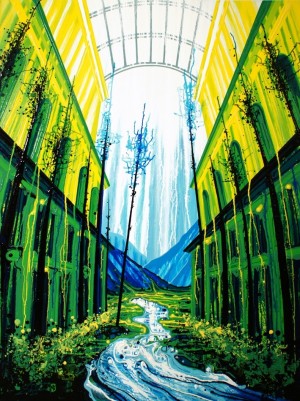Playing With Gravity: One Artist’s Newfound Trademark
“I used to work on un-stretched canvas,” she says. “Since the surface was flexible, I could move it around — the flow of paint. But once I abandoned my brush, I also eliminated the controlled element of my work, which I wasn’t ready to give up. I had to make a change to achieve straight edge details with gravity alone, and you cannot drop straight lines on a bumpy surface.”
Working with both water-based liquid acrylic and enamel paint, a method of control was desperately needed. Through this realization, she created an 8 x 12 foot wall easel that allowed her to spin stretched canvases. Now, with her only task being the befriending of the natural force of gravity, she is able to control the flow of the paint. However, it is not uncommon that she encounters unpredictable results.
“I cannot ensure that the paint will flow where I want, but I can certainly plan for it. I use a level and string to guide straight drips and rotate the canvas slowly to create smooth, curved lines,” she says. “It is amazing what one can do with ketchup bottles, string, and a level.”
As a student at York University, Shackleton was influenced by surrealism. Inspired by the works of Salvador Dali, she was able to discover her own niche and style. However, her motivation to this day remains in locations and foreign places, a source of inspiration that can be seen in each individual piece she creates as well as in her studio.
Indeed, Shackleton’s studio is just what one would expect. The wall where her paintings are created is covered in lusciously multihued, watered down acrylic and enamel paint used from past cityscapes and landscapes. Carefully defining the space as “colorful,” she explains, “My wooden wall easel is textured with hundreds of layered drips — it is an artwork within itself.” Adding that her “bottles are organized by color in a wooden cupboard.” Be that as it may, despite all her feats and interest in art, astoundingly, Shackleton did not begin painting until her upper years at York University in Toronto. The young, eccentric artist grew up in a small town in a family cottage, and had often contemplated going into design to become “more employable.” Though she swayed as a high school student in deciding whether art would be a financially stable career choice, she decided to forgo a life of expense and decided to pursue her dream.
“I first discovered my love for art in kindergarten,” she says. “I have always had a soft spot for nature and could never imagine living in a big city. When I moved to Toronto, I experienced a shift. I realized all the benefits of city living, but I missed nature and started to think of ways to bring it back to the city.”
Her passion for nature is blatantly expressed through her landscape renditions. Particularly in the painting Nightlife, where she manages to capture bold and colorful movement. The dynamic of serene color in a city set in blue hues extends to an impressive piece invoking calming emotions. When asked what she is trying to portray through this process she says, “I can’t help it. I love bright colors. I also think they help express a more positive outlook on the future of cities.” Though the colors in her work are initially inspired by the location and the photo itself, she enhances and changes them in a way she sees best fit to capture the true essence of the place.
Sustainability is a common theme laced throughout her pieces. Her current solo exhibit, and most favorable to date, Terraces: A Series of Steps to a Sustainable Future, displayed at The Elaine Fleck Gallery in Toronto, focuses on the significance of urban agriculture for sustainable development. Like many of Shackleton’s landscape portrayals, the series, encapsulating terraced land, was inspired by designs centered in Italy and Peru. Through her series she sought to transform modern architecture into sustainable designs that she viewed during her travels.
Traveling the world serves as her main influence and motivation. Having explored parts of Ontario, Quebec, Alberta, Croatia, Vienna, Peru, New York, Chicago, Boston, England and Morocco, to name a few, she has gained exposure to numerous architectural platforms.
“I definitely travel a lot to gather inspiration,” she says. “The planning process for each painting begins with the photos I take in urban and wild areas. I digitally alter, overlap, and transform the contrasting photos in Photoshop to create a study. The study outlines the subject matter, composition, and color palette that I plan to use.”
Currently, Shackleton is working on a new series of sustainable buildings. “I just received an Emerging Artist Grant from Ontario Arts Council to begin The Canada Project, she explains. “This project will expose the recent developments of sustainable building across Canada. Over the next couple years, I will be visiting, photographing, and painting imagery from every province and territory in Canada. I will then create a multi-panel painting that forms one large, futuristic Canadian urban landscape. I am excited to get started.”
Throughout history, artists, such as Jackson Pollack, have befriended similar techniques to that of Shackleton’s. Her emerging talent has dominated the abstract method and transformed interpretive art into influential landscapes with eco-friendly undertones. As a result, her style is not something one will come across easily in the art world today – she might even be one-of-a-kind.
“There are some great painters out there who have discovered unique, recognizable styles, she says. “I have seen other painters use drips to create abstract works, but I have yet to see anyone working like I do.”


